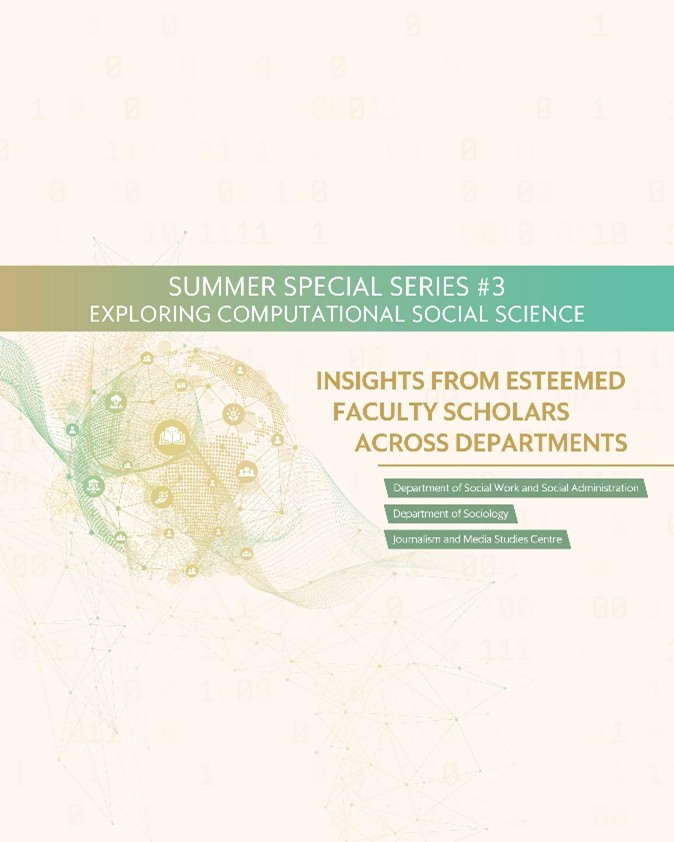Welcome back to our summer series exploring the transformative field of Computational Social Science (CSS) in the Faculty of Social Sciences.
In the last chapter, we introduced CSS and began examining its intersections with traditional social science areas such as Geography, Politics and Public Administration, and Psychology. As we continue our journey, this chapter shifts focus to explore how CSS intersects with the disciplines of Social Work and Social Administration, Sociology, and Journalism and Media Studies.

CSS is redefining how these disciplines approach research, practice, and societal impact by integrating computational techniques with deep social insights. This chapter features insights from our esteemed faculty members who will share their experiences and highlight the innovative applications of CSS in their respective fields. Learn how CSS is enhancing social administration, enriching sociological research, and transforming journalism and media studies with new analytical tools and methodologies.
Join us as we uncover the unique contributions of CSS to these disciplines, driving impactful change and fostering interdisciplinary collaboration. Stay tuned for more insights and perspectives in the next chapter, as we continue to unravel the capabilities of CSS and its influence on the future of social sciences.
Don’t miss this opportunity to gain a deeper understanding of how CSS is opening new dimensions and creating pathways for innovation across diverse fields.
Department of Social Work and Social Administration

Jian Gao, Assistant Professor
My research interests lie in the burgeoning interdisciplinary fields of CSS and Science of Science. I use massive, large-scale datasets from the real world and develop computational tools to study complex social and economic systems. Specifically, my research has three interconnected thrusts. First, I study the uses and benefits of AI in scientific research, given the growing capabilities of AI to advance science and innovation. Second, I examine how science interacts with society and ultimately contributes to human well-being in both tangible and intangible ways. Third, I study the behavioural dynamics of researchers and higher education in training the future generation of scientists and innovators. In particular, my work recognises the crucial fact that solutions to many of the challenges facing society today rely on science, indicating that it is important for us to understand how science relates to wider aspects of society.
In recent years, new opportunities for social science research have emerged primarily due to the convergence of three forces. First, there is an increasing availability of new datasets that can capture social processes in great detail and at a large scale. Second, there is a rapid development of AI and computational tools, such as large language model (LLM) that provide a powerful toolkit for analysing data and making predictions. Third, there is an emergence of new branches of science, such as CSS and Science of Science, which provide new insights into science and society. These exciting opportunities and advancements have enabled a new line of interdisciplinary research that tightly integrates data-driven computational methods and social science perspectives. Together, many areas of social science research are likely to experience methodological shifts in leveraging these new capabilities, and their research insights may find ways to translate more quickly into societal benefits.
Department of Sociology
 Guy Abel, Professor
Guy Abel, Professor
My research is dedicated to applying statistical methods to understand population change. In particular, I work on developing methods for quantifying migration flows and exploring how migration varies by core demographic variables such as age, sex and educational attainment. Migration is increasingly important in many countries’ social, economic, and political issues. However, data to monitor migration patterns and assess their impact are often scarce or measured non-uniformly, prohibiting effective comparisons. This gap presents a significant opportunity for the development and application of advanced statistical methods to enhance migration data quality.
CSS is integral to my work. I have worked extensively to measure global migration flows, where in many countries, only fragments of data on migration levels exist. Based on statistical missing data methods, I have developed demographic accounting techniques that estimate global migration flows that match known changes in migration and population data. These estimates provide, for the first time, a guide to the level and trends of migration flows between all countries, which have been used to help inform population projections and generate future scenarios for the global migration network. I have also worked with researchers at Meta to map how global migration flow patterns evolved before, during, and after the COVID-19 pandemic, based on the activities of over 3 billion Facebook users. In this research, we established an algorithm to detect if and when Facebook users were moving countries to match a standard definition of migration recommended by the United Nations. We then created a model to account for the different Facebook penetration rates across different countries, to enable our final migration flow estimates to represent moves from the entire population rather than solely social media users.
One of the most exciting emerging trends in CSS is the use of big data and machine learning algorithms to predict and understand social behaviour. These advancements not only enhance our academic understanding but also have significant implications for policy-making, enabling more informed and data-driven decisions. Migration data from official statistics often suffers from lengthy publication lags, and predicting longer-term trends has been challenging due to the lack of historical data and the complexity of factors influencing migration. To address these issues, my colleagues and I are embracing new machine learning methods to nowcast current migration patterns and generate realistic scenarios for longer-term trends. These approaches can help governments anticipate migration flows and plan accordingly, leading to more effective policies.
 Lai Wei, Assistant Professor
Lai Wei, Assistant Professor
I am a scholar of social inequality and mobility, and I study how people in this society have different statuses and why. The area has benefited significantly from the recent development of computational tools. In terms of data collection, we now have access to much richer data sources to understand social inequality. For instance, mobile-phone based location data helps us understand how people from different social classes spend their days in different types of venues. Job description data tells us what kinds of jobs and what types of skills are most rewarding. Text data from curricula tells us what knowledge has been increasingly taught in universities. In terms of enhanced estimation accuracy provided by machine learning algorithms, we can now more accurately predict people’s life outcomes. It provides us with more accurate estimates about, for instance, the effect of college on future income, the impact of wealth on mental well-being, among other things.
I think gradually the new forms of data and the more advanced algorithms developed in recent years will be integrated into social science, which would enable us to answer a broader array of questions and answer those questions with greater accuracy.
Journalism and Media Studies Centre

Bin Chen, Assistant Professor
My research focuses on the social and political implications of emerging media, particularly in areas such as social media and politics, digital journalism, and comparative media studies. CSS is a vital part of my work, especially through multi-modal data analysis, inferential network analysis, and the integration of AI in communication research. The CSS approach enables a more systematic and scalable examination of media and communication issues, providing new insights into media use, information flows, and their societal effects.
One of the most exciting directions I am currently pursuing is the comparative study of AI-mediated communication. In particular, I examine (1) how different AI models work in journalism and everyday communication—for example, how they recommend news or write news—and (2) how these differences shape public’s knowledge, perceptions, and attitudes toward social and political issues. Comparing these systems across contexts reveals not only functional differences but also the biases embedded in their training data and algorithms. It highlights both internal factors (e.g., model design) and external influences (e.g., politics, regulation, and culture) that shape AI behaviour. These insights are crucial for understanding AI’s broader impact on communication, public discourse, and the evolving global media landscape.
CSS is particularly powerful in this line of work because it enables the integration of computational tools with critical, comparative thinking. The rise of generative AI presents both opportunities and challenges, especially in understanding how automated systems mediate public knowledge. These tools allow researchers to simulate and test real-world communication scenarios in ways that were not previously possible. At the same time, they raise urgent questions about transparency, accountability, and equity in AI-mediated communication.
Looking ahead, I see CSS playing a crucial role not only in academic research but also in shaping public policy and societal debates. As AI becomes more embedded in media, education, and governance, CSS offers the methodological and theoretical framework to evaluate its impact critically and constructively. By bridging disciplines and linking data with context, CSS helps us better understand the technological forces reshaping our world—and how we might guide them toward more inclusive and informed futures.
 King-wa Fu, Professor
King-wa Fu, Professor
CSS emerged as an academic term in a Science paper published in 2009–the same year I completed my PhD and began researching China’s social media landscape using computational methods, data-intensive techniques, and machine learning algorithms. The CSS approach has become increasingly essential for investigating the exponential growth of digital social media data, the complexity of online network interconnectivity at unprecedented scales and granularity, and for uncovering previously inaccessible patterns and insights.
Exciting research has been conducted over the past decade, incorporating techniques such as big data analytics, network analysis, natural language processing, and agent-based modelling. Numerous novel developments are underway to study a broader scope of human behaviours and social dynamics. For example, the use of generative AI in CSS can potentially automate data annotation and synthesis, scaling up research projects beyond what was previously impossible. The introduction of causal inference in CSS helps address crucial questions about causality in various social science research projects. More tools are being developed and deployed in multiple research areas in social science. These advancements have implications for academic researchers, facilitating cross-disciplinary collaboration and enabling more ambitious projects. For broader societal applications, CSS research can inform evidence-based policy-making, generating insights for decision-makers in areas such as public health, population studies, urban planning, and social welfare.
#1 Exploring the Human Stories Behind Big Data: New Computational Social Science Major Bridges Social Sciences and Data Analysis
#2 From Theory to Practice: The Launch of Computational Social Science
